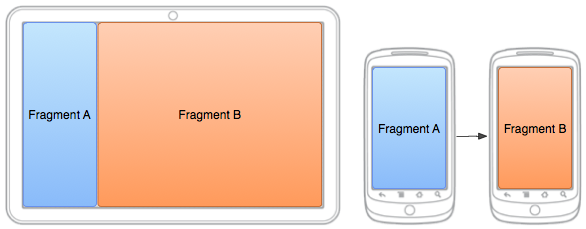建立靈活動態的UI
編寫:fastcome1985 - 原文:http://developer.android.com/training/basics/fragments/fragment-ui.html
-
如果我們的APP設計成要支持範圍廣泛的屏幕尺寸時,在可利用的屏幕空間內,我們可以通過在不同的佈局配置中重用fragment來優化用戶體驗。
-
比如,一個手持設備可能適合一次只有一個fragment的單面板用戶交互。而在更大屏幕尺寸的平板電腦上,我們可能更想要兩個fragment並排在一起,用來向用戶展示更多信息。
**圖1:**兩個fragments,在同一個activity不同屏幕尺寸中用不同的配置來展示。在大屏幕上,兩個fragment被並排放置,在手持設備上,一次只放置一個fragment,所以在用戶導航中,兩個fragment必須進行替換。
- FragmentManager類為在activity運行時對fragment進行添加,移除,替換等操作提供了方法,來實現動態的用戶體驗。
在activity運行時添加fragment
-
比起用
<fragment>標籤在activity的佈局文件中定義fragment,就像上節課說的,我們還可以在activity運行時動態添加fragment,如果打算在activity的生命週期內替換fragment,這是必須的。 -
為了執行fragment的增加或者移除操作,必須通過 FragmentManager 創建一個FragmentTransaction對象, FragmentTransaction提供了用來增加、移除、替換以及其它一些操作的APIs。
-
如果我們的activity允許fragment移除或者替換,我們應該在activity的onCreate()方法中添加初始化fragment(s).
-
運用fragment(尤其是那些在運行時添加的)的一個很重要的規則就是在佈局中必須有一個容器View,fragment的layout將會放在這個view裡面。
-
下面的這個佈局是上節課的一次只顯示一個fragment的佈局的替代佈局。為了從一個佈局替 ctivity的佈局包含了一個空的 FrameLayout作為fragment的容器。
-
注意文件名與上節課的佈局一樣,但是文件目錄沒有
large標識, 所以這一佈局將會在比large小的屏幕上被使用,因為該屏幕無法滿足同時放置兩個fragments
res/layout/news_articles.xml:
<FrameLayout xmlns:android="http://schemas.android.com/apk/res/android"
android:id="@+id/fragment_container"
android:layout_width="match_parent"
android:layout_height="match_parent" />
- 在activity中,用Support Library APIs調用 getSupportFragmentManager()方法獲取FragmentManager 對象,然後調用 beginTransaction() 方法創建一個FragmentTransaction對象,然後調用add()方法添加一個fragment.
- 可以使用同一個 FragmentTransaction進行多次fragment事務。完成這些變化操作,準備開始執行改變時,必須調用commit()方法。
下例顯示瞭如何添加一個fragment到之前的layout中
import android.os.Bundle;
import android.support.v4.app.FragmentActivity;
public class MainActivity extends FragmentActivity {
@Override
public void onCreate(Bundle savedInstanceState) {
super.onCreate(savedInstanceState);
setContentView(R.layout.news_articles);
// Check that the activity is using the layout version with
// the fragment_container FrameLayout
if (findViewById(R.id.fragment_container) != null) {
// However, if we're being restored from a previous state,
// then we don't need to do anything and should return or else
// we could end up with overlapping fragments.
if (savedInstanceState != null) {
return;
}
// Create a new Fragment to be placed in the activity layout
HeadlinesFragment firstFragment = new HeadlinesFragment();
// In case this activity was started with special instructions from an
// Intent, pass the Intent's extras to the fragment as arguments
firstFragment.setArguments(getIntent().getExtras());
// Add the fragment to the 'fragment_container' FrameLayout
getSupportFragmentManager().beginTransaction()
.add(R.id.fragment_container, firstFragment).commit();
}
}
}
- 因為fragment是在activity運行時被添加進來時(不是在XML佈局中用
<fragment>定義的),activity 可以移除這個fragment或者用另外一個來替換它。
替換Fragment
- 替換fragment的過程類似於添加過程,只需要將add()方法替換為 replace()方法。
- 記住在執行fragment事務時,如移除或者替換,我們經常要適當地讓用戶可以向後導航與"撤銷"這次改變。為了讓用戶向後導航fragment事務,我們必須在FragmentTransaction提交前調用addToBackStack()方法。
**Note:**當移除或者替換一個fragment並把它放入返回棧中時,被移除的fragment的生命週期是stopped(不是destoryed).當用戶返回重新恢復這個fragment,它的生命週期是restarts。如果沒有把fragment放入返回棧中,那麼當它被移除或者替換時,其生命週期是destoryed。
- 下面是一個fragment替換的例子
// Create fragment and give it an argument specifying the article it should show
ArticleFragment newFragment = new ArticleFragment();
Bundle args = new Bundle();
args.putInt(ArticleFragment.ARG_POSITION, position);
newFragment.setArguments(args);
FragmentTransaction transaction = getSupportFragmentManager().beginTransaction();
// Replace whatever is in the fragment_container view with this fragment,
// and add the transaction to the back stack so the user can navigate back
transaction.replace(R.id.fragment_container, newFragment);
transaction.addToBackStack(null);
// Commit the transaction
transaction.commit();
- addToBackStack()方法提供了一個可選的String參數為事務指定了一個唯一的名字。除非打算用FragmentManager.BackStackEntry APIs來進行一些高級的fragments操作,這個名字不是必須的。
